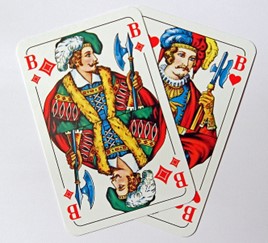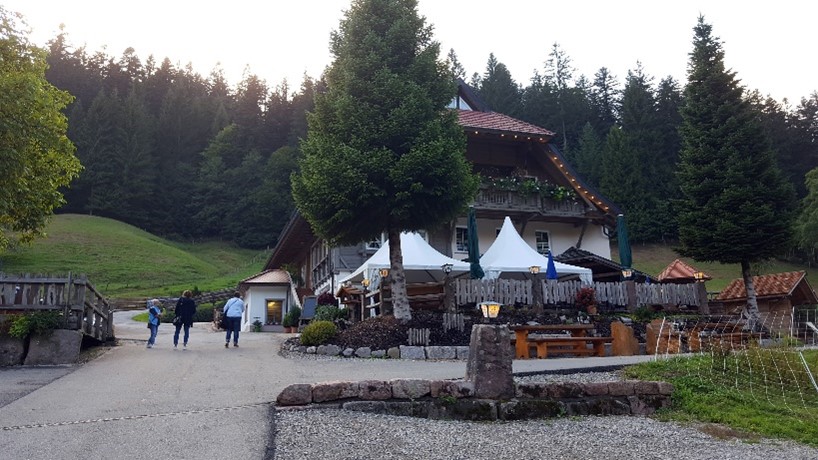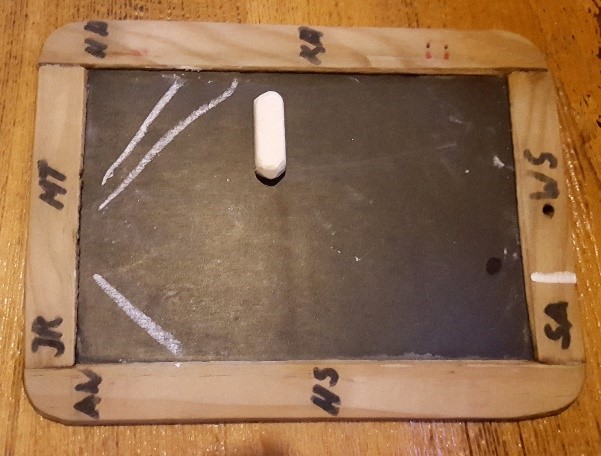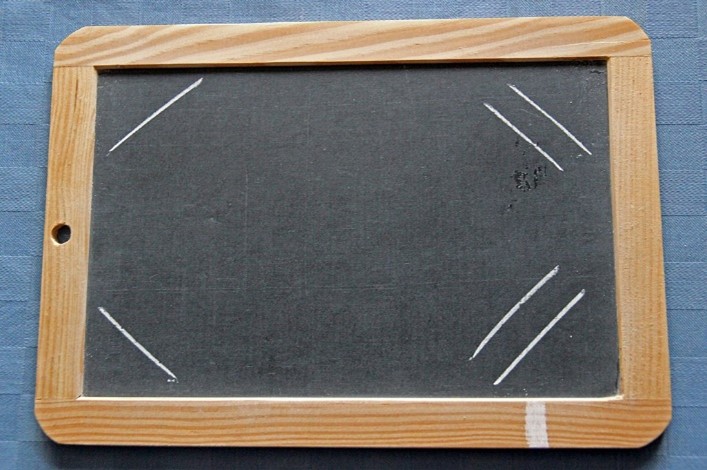Hindersche

A 4-player card game from the Black Forest in which the main object is to avoid taking tricks containing card points.
Class: Reunion Group, Reverse Games
Region: Germany
Introduction
Hindersche, also known as Vier-Strich, is an unusual and little known reverse game that is only played in the central Black Forest in Germany. It is reputed to be over 200 years old and once played by farmers, foresters and journeymen in the Principality of Fürstenberg. Today it is only played in the valleys of the Kinzig and the Wolf, in particular, within a 20 mile radius of Bad Rippoldsau including the settlements of Kaltbrunn, Oberhammersbach, Oberwolfach, Schapbach, Schenkenzell and Wolfach. It is popular enough for regular tournaments to be held alongside annual ‘world championships’ organised by the Schapbach Sports Club.
According Uwe Schoch, the rules of Hindersche were handed down by word of mouth until he captured and published them online in 2014. The fact that it uses a 36-card pack, is played anticlockwise and is an Ace-Ten game with Tens ranking low suggest it is of considerable antiquity, although the earliest historical evidence only dates to 1933. The name Hindersche means ‘backwards’ in the local Swabian dialect and it may have developed from another local game called Viersche whose rules are very similar but whose name means ‘forwards’. Viersche is also known as Hundert (‘hundred’) thanks to its target score.
This page is based on Paul Eaton’s article in The Playing-Card, Vol. 51, No. 3 (2022) which, in turn, was based on research that included a field trip to the Black Forest where he met at the Alte Tränke pub in Schafbach on 15 September 2022 and learned the game from Kurt Bonath (host), Stéphane Augst, Kurt Bonath, Hubert Heizmann, Josef Ruf, Karl-Heinz Schmid, Werner Schmid, Martin Thörmer and Alfred Weiss. Thanks are also due to Uwe Schoch for his advice on the rules.
The playing cards depicted above are the jacks of diamonds and hearts from a Jass/Tapp pack, © ASS Altenburger. Pack design: Berlin or North German pattern, originally designed before 1856. Cards depicted by kind permission of ASS Altenburger.
There are a few rule details about which we are currently uncertain - these are given below in italics.
Overview

The Alte Tränke in Bad Rippoldsau
Hindersche is a four player, non-partnership, Ace-Ten game in which the ‘last in loses’. It is played in two phases. The first comprises a round of up to four deals, in each of which the player with the most points in tricks loses. The loss is reprented by a mark on the slate and the phase ends as soon as there are four marks, hence this phase is called Vier-Strich or 4-Strich (“four line”) like the alternative name of the game.
In the second phase, known as Butzen (“cleaning”), the player with the lowest score in each deal erases a mark and ‘gives it’ to the one with the highest. Anyone who has no marks at the start of phase two or erases their last mark during phase two drops out. The final stage begins when only two players are left and marks are erased but not added. The last player left in is the loser of the game and receives a line drawn on the frame of the slate. There are typically 4 games in a rubber (Runde) which lasts 1 to 1½ hours.
Hindersche has some other unusual features besides its quirky scoring system. It is actually legal to collect a trick you didn't win provided the others don't object; this is called schleipfen after an old forestry term which means “to haul (logs)”. Also if two or three players tie on points they may be required to hold a playoff to decide the result.
Players and Equipment
There are 4 players; each playing on his or her own account. The game is dealt and played anticlockwise
A 36-card, French-suited Jass/Tapp pack is used, but players found these hard to obtain (they are now out of production) and so usually shortened a standard 52-card pack, Berlin pattern pack by removing the 2s to 5s and any Jokers. Cards rank in their natural order, Aces high, and have the usual Ace-Ten values with two exceptions: the Jack of the trump suit, the Old Man (de Alt), is the highest trump; and the ‘next’ Jack (i.e. Jack of the same colour as the trump Jack), the Little Man (de Kloei), is the second highest trump. Both are worth 12 points. The ranking (from high to low) and the point values of the cards are as follows:
| Trumps | Non-trumps | ||
|---|---|---|---|
| card | points | card | points |
| Jack | 12 | Ace | 11 |
| Next Jack | 12 | King | 4 |
| Ace | 11 | Queen | 3 |
| King | 4 | Jack | 2 |
| Queen | 3 | Ten | 10 |
| Ten | 10 | Nine | 0 |
| Nine | 0 | Eight | 0 |
| Eight | 0 | Seven | 0 |
| Seven | 0 | Six | 0 |
| Six | 0 | ||
Scores are chalked on a slate and a small sponge or cleaning cloth is used to erase them again.
Deal
Players draw cards from the pack and the one with the lowest card deals first, or sometimes the honour of dealing first is given to the newest player to join the group. Thereafter the turn to deal passes to the right.
The dealer shuffles, offers the pack to the left for cutting and deals 9 cards to each player in three batches of 3, beginning with forehand (the player to dealer's right).
At the end of the deal a card is turned face up, whose suit will be the trump suit for the hand. When there are four active players in the game, the whole pack is dealt out to the players and the bottom card of the pack, which belongs to the dealer, is turned up. This upcard is left on the table while players arrange their cards and the dealer picks it up when the play begins.
In phase two of the game players will progressively drop out, so that only 2 or 3 active players may remain. In this case the dealer still deals 9 cards to each active player in packets of 3, but now the remaining 9 or 18 cars are out of play and are stacked face down on the table. The dealer turns the top card of this stack face up to determine the trump suit.
Rules of Play
Forehand (the nearest active player to dealer's right) leads to the first trick. Holding a card of the suit led you must either follow suit or play a trump. If you have no card of the suit that was led you may play any card. The player who takes the trick is the one who played the highest trump or, if no trumps were played, the highest card of the led suit. The trick taker leads to the next trick.
You may accidentally or deliberately pick up a trick that is not legally yours (for example by ignoring a trump played by another player) and proceed as though you had won the trick, provided that there is no objection from your opponents before you lead to the next trick. This is known as a Schleipfe.
Scoring
At the end of a deal, after all nine tricks have been played, each player works out their own score by counting up the total point value of cards they took in their tricks. There is a total of 140 card points in the pack. The result is recorded on the slate in marks and games. Each player is allocated a corner of the slate corresponding to their seating position, and each diagonal line (mark) across a corner of the slate represents one penalty point for the corresponding player. Each lost game is represented by line drawn on the wooden frame of the slate. In tournament play the lost games are known as Bollen (blobs) and the player who acquires most of these during the tournament is the Bollenkönig (blob king).
A game is played in two phases or rounds (Runden) each of which normally lasts for several deals, and normally four games constitute a rubber.
Phase 1 – Vier-Strich or 4-Strich

Scoring. One player already has 1 game
point recorded on the frame. In the current
game, one player has lost twice and
another once with one more deal to go.
Phase 1 comprises up to four deals but ends as soon as four or more marks are chalked on the slate, hence the name Vier-Strich (“four lines”). The procedure is:
- The player with the most points (if less than 100) at the end of a deal receives 1 mark.
- A player who takes 100 or more card points in tricks has made a ‘march’ (Durchmarsch). This player wins and the three opponents are given 1 mark each.
- If two or three players tie for most points, those involved in the tie hold a playoff to determine who gets the mark.
- If everyone scores exactly 35, each of the four players receives 1 mark.
Normally Phase 1 ends with 4 marks on the slate; if, however, a player has made 100 in the third or fourth deal or if all four players tie on 35 after at least one deal has been played, there will be 5 to 7 marks. The marks above 4 are called excess marks.
At the end of the first phase any players who have no marks on the slate drop out of the game - they cannot lose and do not take part in phase 2.
If a player loses all the first four deals (and there is no march), that player loses the entire game and there is no Phase 2. Two lost games are chalked for that player on the frame of the slate and there is a ritual whereby the others all stand and point at them in recognition (or mockery) of their misfortune.
Phase 2 - Butzen

Phase 1 – Vier-Strich – has been played out, but
one player has ‘made 100’, so there are 6 marks
instead of the usual four. One player already
has a penalty point on the frame.
Phase 2 consists of as many deals as required until there is only one player left in who is the overall loser. It begins as soon as there are 4 or more marks on the slate in Phase 1.
In each deal, the player who scores the fewest card points erases 1 mark, hence the name Butzen ("cleaning off”), and if there are no excess marks the player with the highest score adds a mark to their corner of the slate.
During Butzen, a march is achieved either by 'making 100' or by taking all 9 tricks. A player who makes a march erases 2 marks and if there are no excess marks the opponents each add 1 to their tally.
During Butzen, if all players tie with the same number of card points, no marks are added or erased.
As players erase their last mark, they drop out. If a player who drops out was due to deal next, the deal passes to the next player who is still in the game.
When three players have dropped out the last player left in is the loser of the game and is penalised with a single chalk mark on the frame of the slate, regardless of how many marks are left on the slate. The marks are cleaned from the slate ready for the next game to begin.
In detail, the process is as follows.
When there are excess marks and at least three players:
If there are more than four marks on the slate, marks are erased but not added.
- Normally, sufficient marks are erased in the next deal to get down to a total of 4 marks. So if there are 5 marks on the slate, in the next deal 1 mark is erased by the player with the lowest score; if there are 6 marks, the players with the lowest two scores each erase 1 mark. If there are 7 marks, all except the player with the highest score erase 1 mark. No one adds marks.
- If a player makes a march, that player erases 2 marks if there are at least 2 excess marks and the player has 2 marks to erase. If there is only one excess mark, or if the player who made march has only one mark, only one mark is erased.
When there are exactly four marks and at least three players:
- The player with the fewest points erases 1 mark, while the player with the most 'receives' the mark erased by the winner. Thus so long as there is no march, there are always 4 marks on the slate.
- A player who makes a march erases all their marks (1 or 2) and drops out, while the opponents each add 1 to their tally. This may create an excess mark, in which case the rules above apply until the marks on the slate are again reduced to four.
When there are only two players:
- When just two players remain, the final stage of the game begins. The winner of each deal erases one mark, or two in the case of march, but no marks are added by the loser.. As soon as one player has erased all their marks, that player drops out and the last remaining player is the loser of the game.
At any stage during Butzen, a player who feels they have an unwinnable hand may ask for “nicer ones” (hübscher) before play begins. If the opponent(s) agree, the cards are thrown in and the same dealer deals again. This normally happens only when there are only two players.
Playoff
In either phase, when two or three players have exactly equal number of points, it may be necessary to resolve the tie in order to determine which player should add or erase a mark. In this case there is an additional 'playoff' deal in which only the tied players take part, and the result is used only to break the tie.
For example, in the Butzen phase with 3 players and 4 marks on the slate, if A and B tie for lowest score, C adds a mark and then sits out while A and B hold a playoff. The winner of the playoff then erases a mark.
In a playoff deal, the cards are dealt by whichever player in the playoff has the earlier turn to deal and the next player in rotation leads to the first trick. When the playoff is settled, the normal game resumes, and the turn to deal passes to the player to the left of the one who dealt for the playoff.
Settlement
Normally four games constitute a rubber. If playing for stakes, at the end of a rubber those with marks on the frame pay each opponent for each mark they have acquired. A typical tariff is € 5.
For example, if A has 3 marks on the frame, B has 1 mark and C and D have none, A pays € 15 and B € 5 to each opponent. Thus A loses €40, B breaks even and C and D win € 20 each. Of course, players can set their own tariff.
Tactics
Being able to play a trump at any time is very useful. For example, if you are in rearhand and you see that the cards so far played are of low value, it may make sense to play your highest trump to get it out of the way. Equally if you are aiming to make a march, you may want to trump a high value trick rather than follow suit and lose it.
Smearing high value cards onto other players is usually a good tactic. To that end it is usually worth voiding suits early on in order to be able to do this.
Leading medium-ranking cards early on is a good option, whilst keeping a low card in each suit – if you can’t void it – is also prudent. Leading a Ten is known as “selling a Tenner” (10er verkaufe) and is done in the hope that someone else will ‘buy it’. Demanding trumps (Trumpf haische) is a tactic to draw trumps out from one’s opponents, to test who has trumps or to work out how they are distributed.
You may schleipfen deliberately if you are aiming to make 100 and want to ‘haul off’ a trick with high points; the others may let it go to you because they’re trying to score as few as possible. Even if they suspect you are trying for 100, they may allow you to have the points because they reckon you’re not going to make it. And if you are foolish enough to pick up a high value trick by mistake, the one who should have taken it may well be happy to let it go! Paul Eaton did not notice any schleipfen in the games that he played, and wondered if it would be frowned upon if a player did it too often. It seems a risky tactic.
Essentially you don’t want to be left with high cards or trumps at the end unless you are aiming for a march.
Conclusion
Hindersche is one of those fascinating pieces of local history and culture that so often goes unrecorded. Sometimes reverse games are less fun because tactical play is limited, but this one is unexpectedly enjoyable. It is easy to learn and interesting to play, but tactically challenging to master. Its All Fours rules of play, the option of making 100 and the possibility of a sneaky Schleipfe add interest, uncertainty and opportunities for skilful play.
The game also reflects local culture in the quirky scoring scheme and the laid back way that players are able to rotate in and out of the game or drop out after a successful run and relax while watching those left in engage in friendly combat.